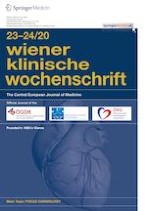Erschienen in:

01.12.2020 | position paper
Recommendations on the utilization of telemedicine in cardiology
verfasst von:
Michael Gruska, Gerhard Aigner, Johann Altenberger, Dagmar Burkart-Küttner, Lukas Fiedler, Marianne Gwechenberger, Peter Lercher, Martin Martinek, Michael Nürnberg, Gerhard Pölzl, Gerold Porenta, Stefan Sauermann, Christoph Schukro, Daniel Scherr, Clemens Steinwender, Markus Stühlinger, Alexander Teubl, Working Group Rhythmology of the Austrian Cardiological Society
Erschienen in:
Wiener klinische Wochenschrift
|
Ausgabe 23-24/2020
Einloggen, um Zugang zu erhalten
Summary
The enormous progress made in recent years in the field of information and communication technology and also in sensor and computer technology has affected numerous fields of medicine and is capable of inducing even radical changes in diagnostic and therapeutic processes. This is particularly true for cardiology, where, for example, telemetric monitoring of cardiac and circulatory functions has been in use for many years. Nevertheless, broad application of newer telemedical processes has not yet been achieved to the extent one would expect from the encouraging results of numerous clinical studies in this field and the state of the art of the underlying technology. In the present paper, the Working Group on Rhythmology of the Austrian Cardiological Society aims to provoke a critical discussion of the digital change in cardiology and to make recommendations for the implementation of those telemedical processes that have been shown to exert positive effects on a wide variety of medical and economic parameters. The greatest benefit of telecardiological applications is certainly to be found in the long-term care of patients with chronic cardiovascular diseases. Accordingly, follow-up care of patients with cardiological rhythm implants, management of chronic heart failure and secondary prevention following an acute cardiac event during rehabilitation are currently the most important fields of application. Telemedicine is intended to enable high-quality and cost-efficient care for an increasing number of patients, whose care poses one of the greatest challenges to our healthcare system. Not least of all, telemedicine should make a decisive contribution to improving the quality of life of this segment of the population by favorably influencing mortality, morbidity and hospitalization as well as the patient’s contribution to treatment.
